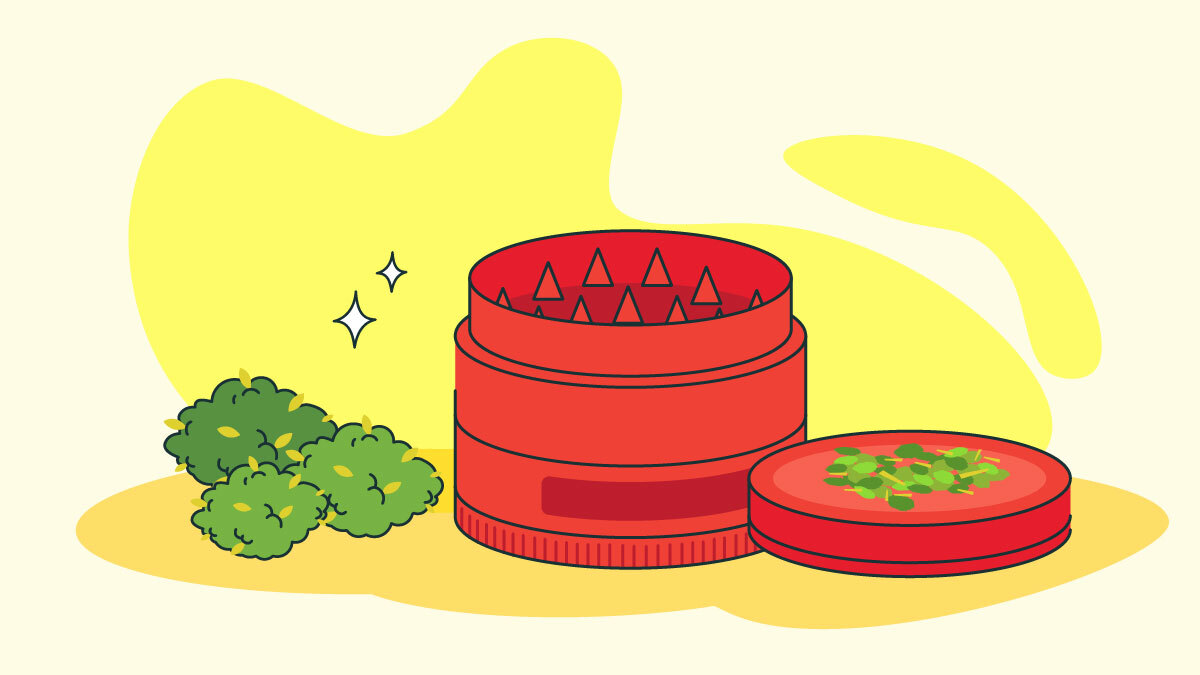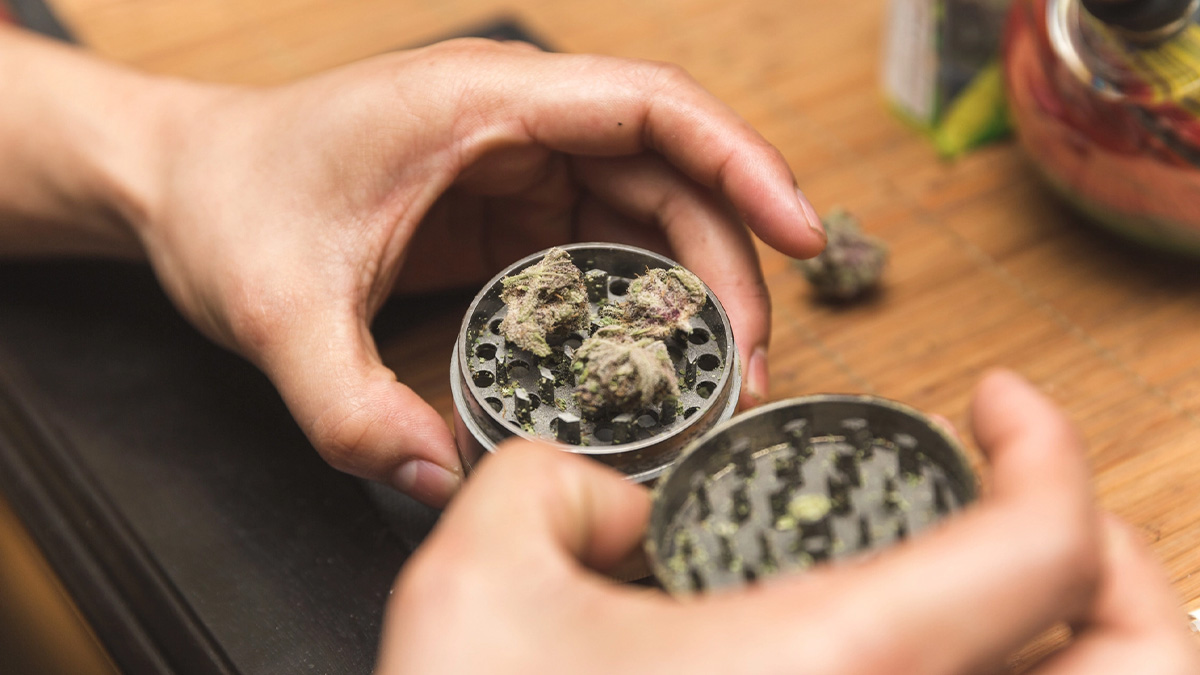How to Use A Grinder

Here’s a sign that someone’s a pro.
They invite you over to share a little herb. When you get there, they pull out their stash. And the next thing they do is pull out a cool-looking grinder.
If someone’s only an occasional weed smoker, they probably break up their bud before rolling a joint. A person who grinds their flower, though, is a serious smoker who knows what they’re doing.
You may be content with using your hands or with letting someone else do the work. But sooner or later, you’re going to have to figure out how to use a grinder.
Why not start now?
Let’s take a look at the different types of grinders you can choose from, how they work, and the best way to use them.
Why Use a Weed Grinder?
We can answer that question with one word: consistency.
When you buy weed (or if you grow your own), the buds are chunky and uneven. If you tried packing a bowl or rolling a joint with them, you’d almost certainly end up with a clogged piece or a misshapen, lumpy joint. Neither will provide the smoking experience you’re looking for. And if you have a small bowl, you probably can’t fit an entire nug into it anyway.
Even if you’re able to spark up, you’ll still be unhappy. Large buds don’t burn evenly, so chances are that only the outside of the nug (and perhaps just a part of it) will catch fire. If you’ve rolled a joint with huge nugs, it’s likely that the flower will just burn down the middle (which is called “canoeing”) or that only the paper will burn.
In short, you’ll end up wasting some of your stashes. But grinding your weed solves those problems. In case, you don’t have a weed grinder at home, there are still ways to grind your weed without one. Your options include using a coffee grinder, a cheese grater, and using a knife and cutting board.
Small, consistently-sized pieces burn nicely and evenly while maximizing airflow through the piece or joint and delivering all the potent smoke you expect. There are other benefits to using a grinder, too. The smoke will be smoother, and grinding unlocks all of the weed’s flavor and aroma. And some grinders let you collect extra-potent kief.
So using a grinder isn’t simply the sign of a heavy smoker. It’s the sign of a smart smoker.
Types of Grinders
Almost all weed grinders are palm-sized and circular (looking somewhat like a hockey puck). Cheap models are made from plastic, while more-expensive ones are made of metal or wood. The cheap ones are simple, and the pricier ones are more complicated, but they essentially work the same way.
Simple grinders have two interlocking pieces. The lid has teeth attached to its underside, and it’s rotated to grind the weed that’s in the bottom piece, commonly known as the grinder chamber or the bud catcher. After grinding, the lid is removed, and the ground weed can be scooped out.
Better models have three, four, or five interlocking pieces.
- A three-piece grinder has a lower collection chamber. Ground weed falls through holes in the bud catcher into the collection chamber for easier removal.
- In a four-piece model, there’s a screen at the bottom of the collection chamber. Small particles of potent kief fall through the screen into yet another chamber called the kief catcher.
- Some five-piece models have two screens between the collection chamber and kief catcher; “dirty kief” is caught between the two screens, and even more-potent “clean kief” falls into the lowest chamber. Other five-piece grinders have two kief chambers, with smaller holes in the screen that separates them.
You need to understand those differences in order to buy a grinder that meets your needs so you’ll know what to do after you’ve ground your weed. But the differences don’t really matter when you’re learning how to use a grinder.
How to Use a Weed Grinder

Always take it slowly when you’re grinding weed. If you’re in a hurry and overstuff the grinder chamber, you’ll end up spending a lot more time cleaning out the mess.
1. Break Up Your Weed
The pieces don’t have to be tiny — that’s what the grinder is for. But break up your nugs into smaller chunks so they will fit easily into the chamber. Don’t forget to remove all of the seeds and stems.
2. Load the Grinder
Remove the lid and place chunks of your bud into the grinder chamber where the grinding teeth can contact them. Don’t put any flower into the middle of the chamber; the teeth won’t hit that area because that’s where the lid pivots.
Don’t overfill the chamber. Loading it with too much bud will either result in a grind that’s too coarse or cause the grinder to stick. Grinding your weed in two batches only takes an extra minute.
3. Grind the Weed
Replace the lid and make sure it’s securely fastened. Hold the grinder in one hand and use the other hand to rotate the lid. About 10-12 rotations should do the trick. You’ll feel resistance at first, but when the tension eases, it means your weed has all been ground.
4. Dislodge the Leftovers
There will probably be some ground weed stuck in the grinder teeth, so rap the grinder on a solid object (or your hand) a couple of times to dislodge the leftover flower.
5. Collect the Ground Weed
Remove the lid. If you’re using a two-piece grinder, scoop out your newly-ground herb. If you have a multi-piece model, collect your bud from the bottom collection chamber. If it’s a four- or five-piece grinder with screens on the bottom of the collection chamber, be careful not to damage the screens.
That leaves one question: what about the kief? After a single grind, you probably won’t have collected enough trichomes to use. Wait until the kief catcher fills up before harvesting all of that yummy weed goodness with a kief scraper or another small tool like a jeweler’s screwdriver.
6. Clean the Grinder
Resin is sticky, of course, and it will build up in your grinder over time. When you find that rotating the teeth is becoming more and more difficult, it’s time to give the grinder a cleaning.
Make sure you’ve removed all of the weed that’s inside, including the kief. Put the grinder in the freezer for an hour to make the resin easier to remove.
Then clean all of the parts (except the screens) with a clean rag soaked in rubbing alcohol until the resin is gone. Gently clean the screens with a toothbrush or stiff-bristled paintbrush. Wash everything with soap and water, and you’re ready to grind your next batch of bud.
How to Use a Grinder: FAQ
Q: Does it matter what type of grinder I buy?
A: The plastic ones won’t last long, and they’re usually simple two-piece models. Metal grinders are sturdier and should hold up for years; they’re more expensive but worth it. Most people choose four-piece grinders in order to have a kief catcher. The five-piece models are fine, but you may find that having two screens or two kief-catchers is overkill.
Q: Aren’t there electric weed grinders?
A: Yes, but the good ones are generally more expensive (and portable, battery-powered ones are usually more costly than plug-in models). The bigger issue is that it’s easy to over grind your weed when all you have to do is push a button to rotate the grinding teeth. Electric grinders can save you a little elbow grease, but be careful you don’t end up with fine powder instead of smokeable herb.